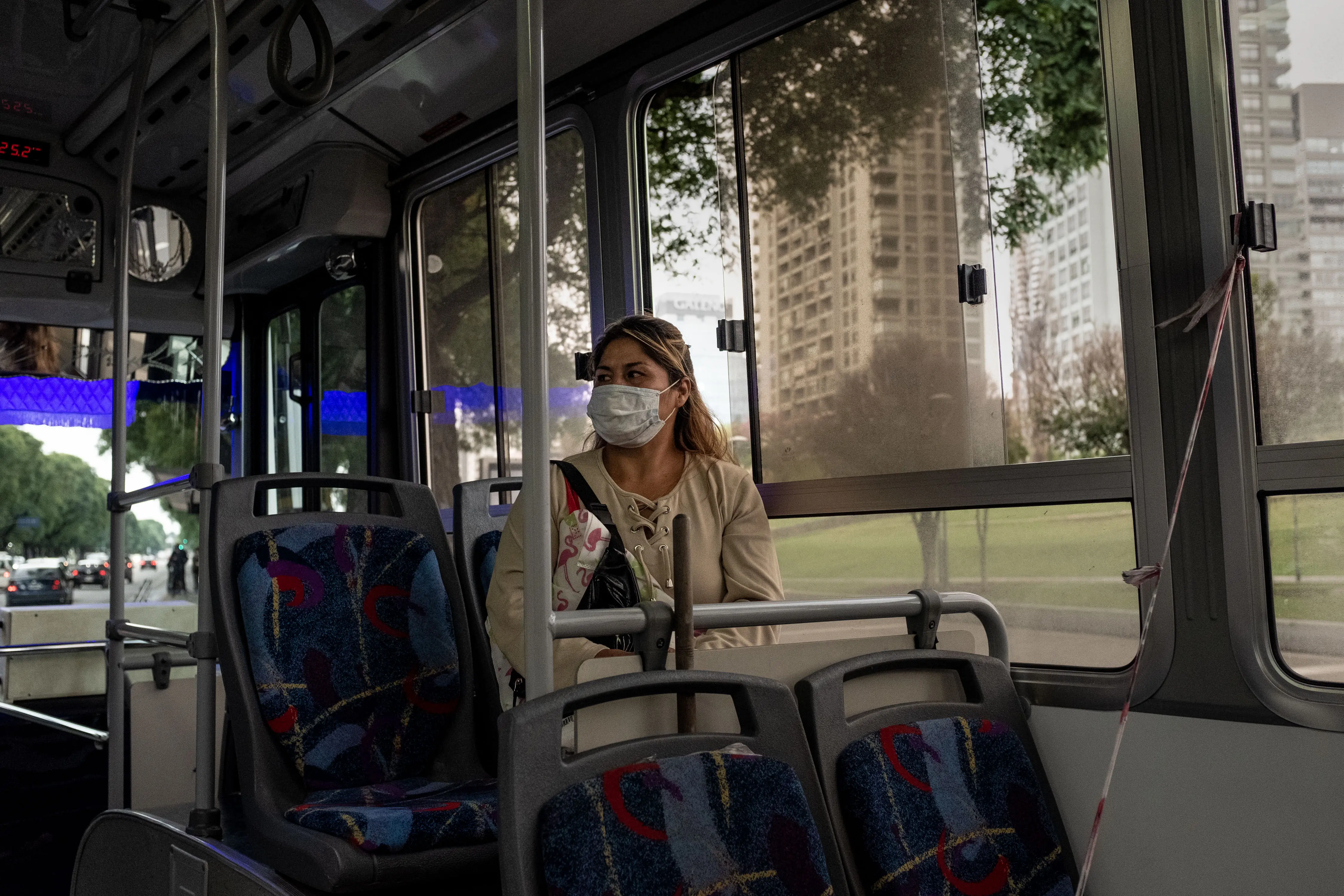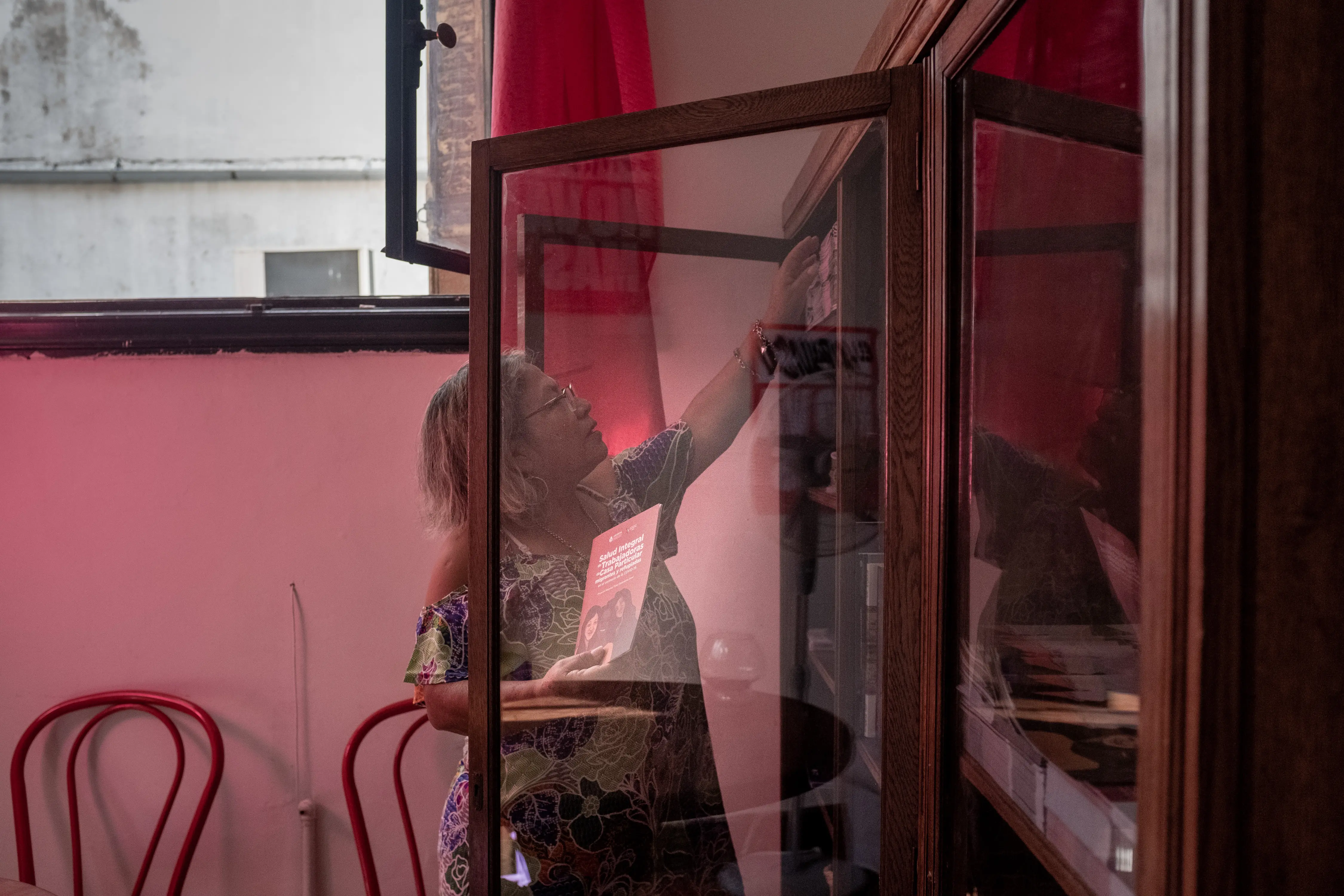
Angelica Lopez takes three buses to work.
She could take two buses, but her left knee hurts. It has hurt for a long while, and she doesn’t have paid sick leave to rely on while she has an operation.
“Whenever I walk, it makes this sound: tok tok tok.” She grins through the pain as she approaches the household cleaning job that will keep her on her feet all day.
Lopez counts herself among those to still have work in the midst of the coronavirus pandemic that has been merciless, especially for women in her position.
Her commute tells you a lot about the world in which she lives. It starts down a laneway around the corner from a tyre shop in Bajo Flores, one of the poorest enclaves of the capital city. She lives on the top floor of a two-story building, in a single room with her grown son who is studying. They share a bathroom and kitchen with the other residents.
The mother of four, and grandmother of seven, takes the same route every day out of her neighbourhood, past the police post and the officer in army fatigues. She skirts a park and murals exalting Jesus, and a grocery store selling ribs at 750 pesos a kilogramme ($7.85), until the stop for the 34 bus. It will take her on a ride, literally and figuratively, past the changing face of Buenos Aires and the chasm that traps its subjects.
The commute ends at the white gates of an exclusive high-rise in the city’s trendy Las Canitas neighbourhood, where Angelica will work for six hours, two days a week. That earns her 10,000 pesos a month, or the equivalent of $105. Her rent costs double that.
“Basically, we’re surviving on luck,” said Lopez, 52, originally from Peru. “Even now, we’re still living in poverty. It’s just not enough.”
That “not enough” has become a galvanising force for a wide and often invisible sector of Argentina’s workforce.
Household workers do a variety of jobs – mostly cleaning tasks, but also caring for children or the elderly. Before the pandemic, the government estimated some 1.4 million women worked in what is known as the domestic sector. The pandemic has almost surely diminished their ranks, and most definitely worsened their working conditions.
A long and strict lockdown prohibited most of them from going out to work. Many lost income, even though they should have received it. Others endured a higher risk of COVID-19 exposure after their employers misclassified them as essential workers in order to dodge shutdown orders.
As COVID-19 restrictions stacked the deck even further against them, these women met each other on the streets of Buenos Aires, fearful of the risks they were taking, but determined to have their voices heard.
Since October, there have been at least seven marches by household workers in Buenos Aires to put pressure on the government to do more to help them.

Collective action
While unions for household workers predated COVID-19, few labourers actually signed up – until now.
“The changes during the pandemic were brutal. Economically, psychologically, morally,” said Lopez, who turned to soup kitchens to survive. “The workers – all of us – lost work. Many of us worked in an informal way, and, to be honest, many of us ended up on the streets, we were evicted… we need a union that is formed by workers, that represents us.”
Household workers represent 8 percent of Argentina’s total workforce and just over 17 percent of all working women. Almost half of these women are the breadwinners in their homes.
Legislation passed in 2013 mandated that all household workers be registered, so their employers would have to pay social insurance, make pension contributions, and give workers paid maternity, sick and bereavement leave. But the vast majority — 77 percent, according to a 2018 study — remain unregistered.
“If you don’t protest, if you don’t make noise, they won’t listen to you. You can’t achieve much by staying silent,” said Estela Avila, 59, who has worked for 40 years cleaning houses and is now the president of a new union called Asociación de Trabajadoras del Hogar y Afines (Association of Household and Related Workers).
It’s not enough, say activists, to scrape by on a meagre salary, which the government sets at 25,000 pesos a month or $262 – less than half of what a family in Argentina needs to survive on without falling below the nation’s official poverty line.
There have been some small victories. This month, a union representing workers and groups representing employers negotiated a 42 percent wage increase over the next year. But the pay bump is not expected to keep up with inflation in the financially volatile country.
But more unions are forming, spearheaded by the women themselves, including one co-led by Lopez under the Partido Obrero (Workers’ Party) of Argentina.
Lopez, who spends a lot of time these days on Zoom and WhatsApp strategising with her fellow union members, has become comfortable standing behind a megaphone at demonstrations.

The most vulnerable
About 9 percent of the household workforce in Argentina are migrants from other countries, a 2018 government study found.
The undocumented are perhaps the most vulnerable workers in the domestic sector. Many, for example, couldn’t access pandemic aid offered by the government. But many see the renewed emphasis on collective action spawned by the pandemic as an opportunity to bring these workers out from the shadows.
“The crisis caused by the pandemic is also an opportunity to make visible the precarious conditions that this labour force lives through,” said Macarena Romero, a political scientist who researches issues related to migration, gender and care work.
“The empowerment that is taking place is not just about a political position. It’s about unmasking the discriminatory, stigmatising and racist xenophobia of many societies, in this case Argentina, that creates the conditions that put these women in vulnerable positions to begin with,” she told Al Jazeera.
Natividad Obeso is the founder of United Migrant and Refugee Women in Argentina – AMUMRA, an organisation dedicated to promoting the rights of migrant women. Originally from Peru, she worked as a cleaning lady in Buenos Aires until the day her employer told her she wasn’t entitled to take a holiday off.
“I removed my uniform that day and put it in the garbage,” she told Al Jazeera.
Obeso helped draft recommendations that shaped the 2013 law. While that represented an important advance for household workers, she says the government has fallen down on enforcement – something she’s working to change.
A major obstacle to holding employers accountable, she says, is that household workers, especially migrants, often lack proof of employment. They may not know their employers’ full names, or even the exact address where they are working.
“So we give them tools – we tell them to take a photo in the bathroom while they’re at work, in the living room, in the bedroom, so that when they stop working, they can show that they were there,” she said.
“We’ve had situations where the superintendent of the building, who is friendly and supports them while they are working, suddenly no longer recognises them once they are fired,” Obeso said. “The things household workers live through is very painful.”












